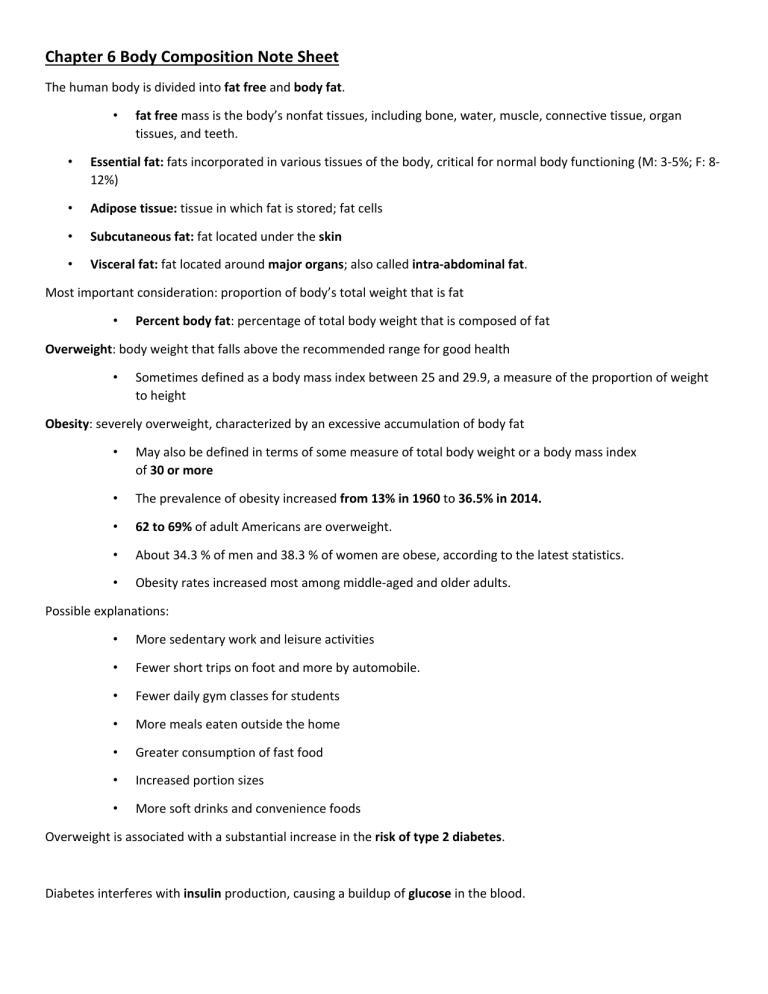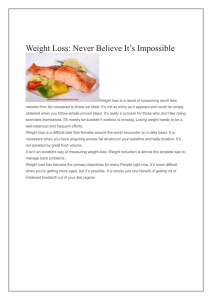
Chapter 6 Body Composition Note Sheet The human body is divided into fat free and body fat. • fat free mass is the body’s nonfat tissues, including bone, water, muscle, connective tissue, organ tissues, and teeth. • Essential fat: fats incorporated in various tissues of the body, critical for normal body functioning (M: 3-5%; F: 812%) • Adipose tissue: tissue in which fat is stored; fat cells • Subcutaneous fat: fat located under the skin • Visceral fat: fat located around major organs; also called intra-abdominal fat. Most important consideration: proportion of body’s total weight that is fat • Percent body fat: percentage of total body weight that is composed of fat Overweight: body weight that falls above the recommended range for good health • Sometimes defined as a body mass index between 25 and 29.9, a measure of the proportion of weight to height Obesity: severely overweight, characterized by an excessive accumulation of body fat • May also be defined in terms of some measure of total body weight or a body mass index of 30 or more • The prevalence of obesity increased from 13% in 1960 to 36.5% in 2014. • 62 to 69% of adult Americans are overweight. • About 34.3 % of men and 38.3 % of women are obese, according to the latest statistics. • Obesity rates increased most among middle-aged and older adults. Possible explanations: • More sedentary work and leisure activities • Fewer short trips on foot and more by automobile. • Fewer daily gym classes for students • More meals eaten outside the home • Greater consumption of fast food • Increased portion sizes • More soft drinks and convenience foods Overweight is associated with a substantial increase in the risk of type 2 diabetes. Diabetes interferes with insulin production, causing a buildup of glucose in the blood. Metabolic Syndrome and Premature Death Metabolic syndrome: cluster of symptoms present in many overweight and obese people that greatly increases their risk of heart disease, diabetes, and other chronic illnesses. Diagnosed if a person has at least three out of five key factors: • Large waistline (fat deposits in abdominal region) • High blood pressure • High fasting blood sugar (due to insulin resistance) • High triglycerides • Low HDL (“good” cholesterol) Conditions associated with metabolic syndrome: • Chronic inflammation: a response of blood vessels to such harmful substances as germs, damaged cells, or irritants; can lead to heart disease, cancer, allergies, and muscle degeneration • Fatty liver: increased fat storage in the liver; can lead to liver inflammation and failure Problems with very low levels of body fat Health experts generally view too little body fat as a threat to health. • Too little for women: less than 8 to 12% • • Amenorrhea: absent or infrequent menstruation, sometimes related to low levels of body fat and excessive quantity or intensity of exercise Too little for men: less than 3 to 5% Female athlete triad: condition consisting of three interrelated disorders • Abnormal eating patterns (and excessive exercising) • A lack of menstrual periods (amenorrhea) • Decreased bone density (premature osteoporosis) Assessing Body Composition Body mass index (BMI): measure of relative body weight correlating highly with more direct measures of body fat • Calculated by dividing total body weight (in kilograms) by the square of body height (in meters) • BMI between 18.5 and 24.9 is considered healthy Underwater weighing • Individual submerged and weighed under water • Percentage of fat and fat-free weight calculated from body density The Bod Pod Small chamber containing computerized sensors measures body composition by air displacement Skinfold measurements • Measures thickness of skinfolds at different places on the body • Caliper: pressure-sensitive measuring instrument with two jaws that can be adjusted to determine thickness of the skinfold • Important to test exact sites, to measure several different times, and to take measurements at approximately the same time of day Bioelectrical impedance analysis (BIA) • BIA works by sending a small electrical current through the body and measuring the body’s resistance to it. Advanced techniques: DEXA and TOBEC • DEXA works by measuring tissue absorption of high- and low-energy X-ray beams. • TOBEC estimates lean body mass by passing a body through a magnetic field. Waist circumference measurement and waist-to-hip ratio calculations are the easiest to perform. A total waist measurement of more than 40 in. for men and 35 in. for women and a waist-to-hip ratio above 0.94 for young men and 0.82 for young women are associated with increased risk of heart disease and diabetes. Somatotype Endomorphs are round and pear shaped, with wide hips and shoulders. Mesomorphs are lean and lean and respond well to exercise. Ectomorphs are thin and linear, with narrow hips and shoulders. Take your own notes on setting goals and making changes in body composition.


